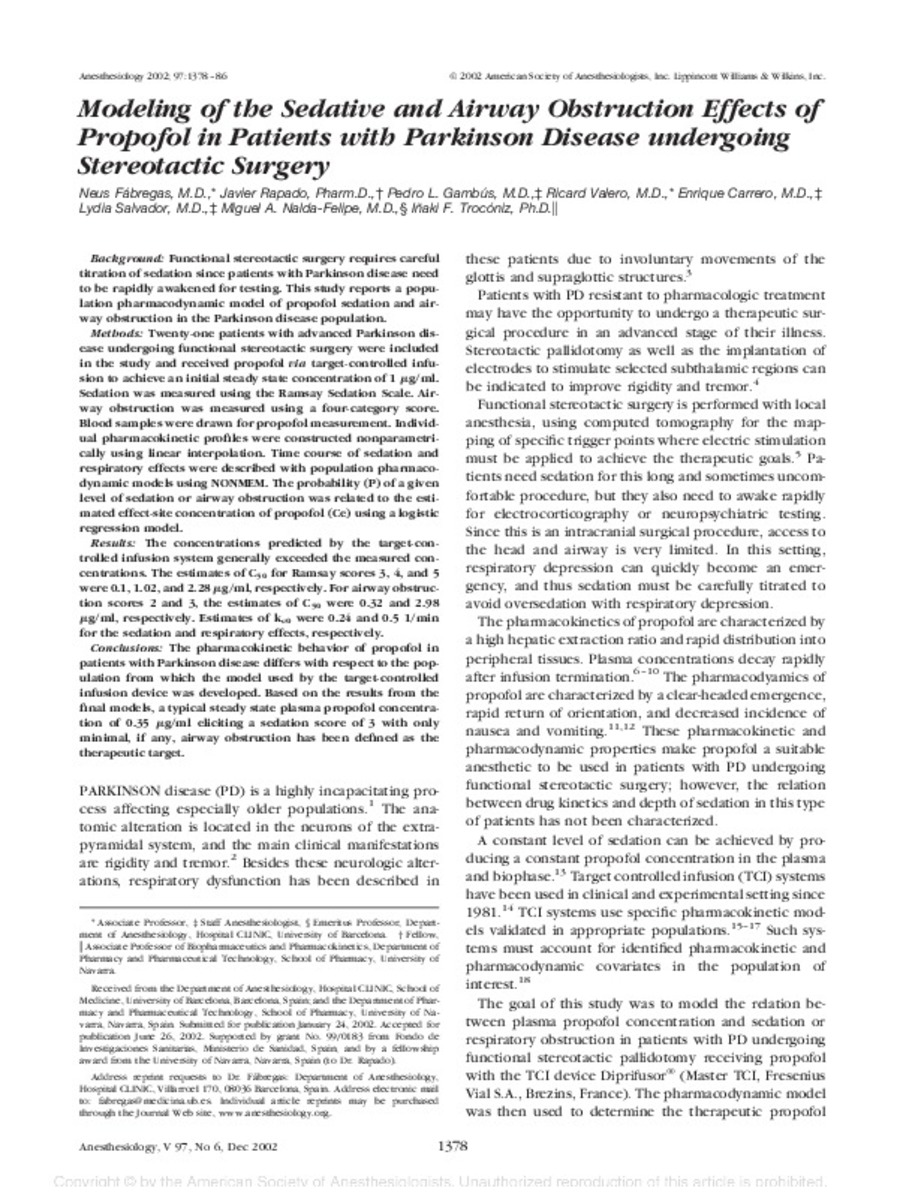Full metadata record
| DC Field | Value | Language |
|---|---|---|
| dc.creator | Fábregas, N. (Neus) | - |
| dc.creator | Rapado, J. (Javier) | - |
| dc.creator | Gambús, P.L. (Pedro L.) | - |
| dc.creator | Valero, R. (Ricard) | - |
| dc.creator | Carrero, E. (Enrique) | - |
| dc.creator | Salvador, L. (Lydia) | - |
| dc.creator | Nalda-Felipe, M.A. (Miguel A.) | - |
| dc.creator | Troconiz, I.F. (Iñaki F.) | - |
| dc.date.accessioned | 2012-04-24T08:22:01Z | - |
| dc.date.available | 2012-04-24T08:22:01Z | - |
| dc.date.issued | 2002 | - |
| dc.identifier.citation | Fábregas N, Rapado J, Gambús PL, Valero R, Carrero E, Salvador L, et al. Modeling of the Sedative and Airway Obstruction Effects of Propofol in Patients with Parkinson Disease undergoing Stereotactic Surgery. Anesthesiology. 2002 Dec;97(6):1378-86. | es_ES |
| dc.identifier.issn | 0003-3022 | - |
| dc.identifier.uri | https://hdl.handle.net/10171/21766 | - |
| dc.description.abstract | BACKGROUND: Functional stereotactic surgery requires careful titration of sedation since patients with Parkinson disease need to be rapidly awakened for testing. This study reports a population pharmacodynamic model of propofol sedation and airway obstruction in the Parkinson disease population. METHODS: Twenty-one patients with advanced Parkinson disease undergoing functional stereotactic surgery were included in the study and received propofol target-controlled infusion to achieve an initial steady state concentration of 1 microg/ml. Sedation was measured using the Ramsay Sedation Scale. Airway obstruction was measured using a four-category score. Blood samples were drawn for propofol measurement. Individual pharmacokinetic profiles were constructed nonparametrically using linear interpolation. Time course of sedation and respiratory effects were described with population pharmacodynamic models using NONMEM. The probability (P) of a given level of sedation or airway obstruction was related to the estimated effect-site concentration of propofol (Ce) using a logistic regression model. RESULTS: The concentrations predicted by the target-controlled infusion system generally exceeded the measured concentrations. The estimates of C(50) for Ramsay scores 3, 4, and 5 were 0.1, 1.02, and 2.28 microg/ml, respectively. For airway obstruction scores 2 and 3, the estimates of C(50) were 0.32 and 2.98 microg/ml, respectively. Estimates of k(e0) were 0.24 and 0.5 1/min for the sedation and respiratory effects, respectively. CONCLUSIONS: The pharmacokinetic behavior of propofol in patients with Parkinson disease differs with respect to the population from which the model used by the target-controlled infusion device was developed. Based on the results from the final models, a typical steady state plasma propofol concentration of 0.35 microg/ml eliciting a sedation score of 3 with only minimal, if any, airway obstruction has been defined as the therapeutic target. | es_ES |
| dc.language.iso | eng | es_ES |
| dc.publisher | Lippincott Williams & Wilkins | es_ES |
| dc.rights | info:eu-repo/semantics/openAccess | es_ES |
| dc.subject | Sedation | es_ES |
| dc.subject | Stereotactic surgery | es_ES |
| dc.subject | Parkinson | es_ES |
| dc.subject | Propofol | es_ES |
| dc.subject | Pharmacokinetics | es_ES |
| dc.title | Modeling of the Sedative and Airway Obstruction Effects of Propofol in Patients with Parkinson Disease undergoing Stereotactic Surgery | es_ES |
| dc.type | info:eu-repo/semantics/article | es_ES |
| dc.type.driver | info:eu-repo/semantics/article | es_ES |
Files in This Item:
Statistics and impact
Items in Dadun are protected by copyright, with all rights reserved, unless otherwise indicated.






